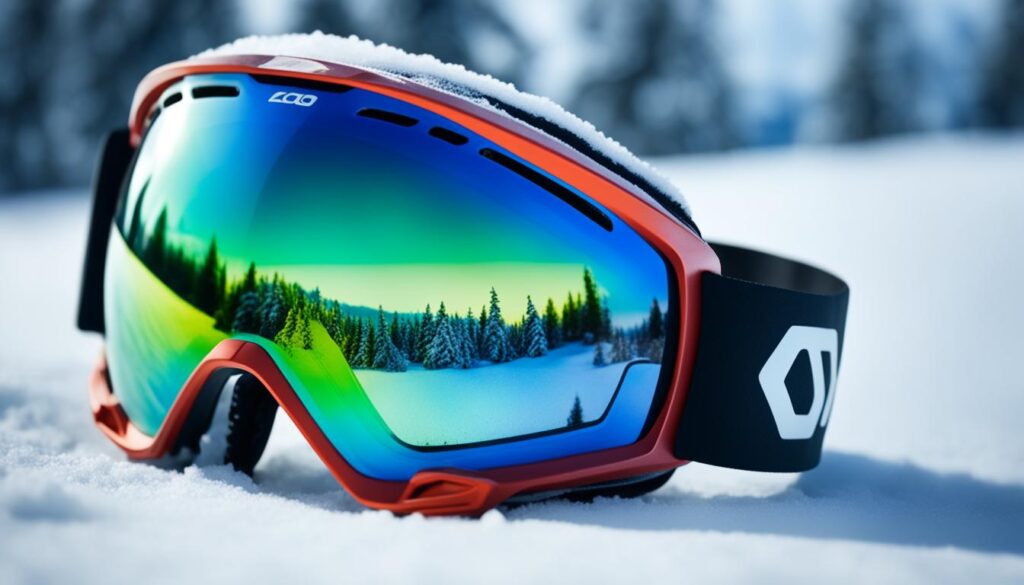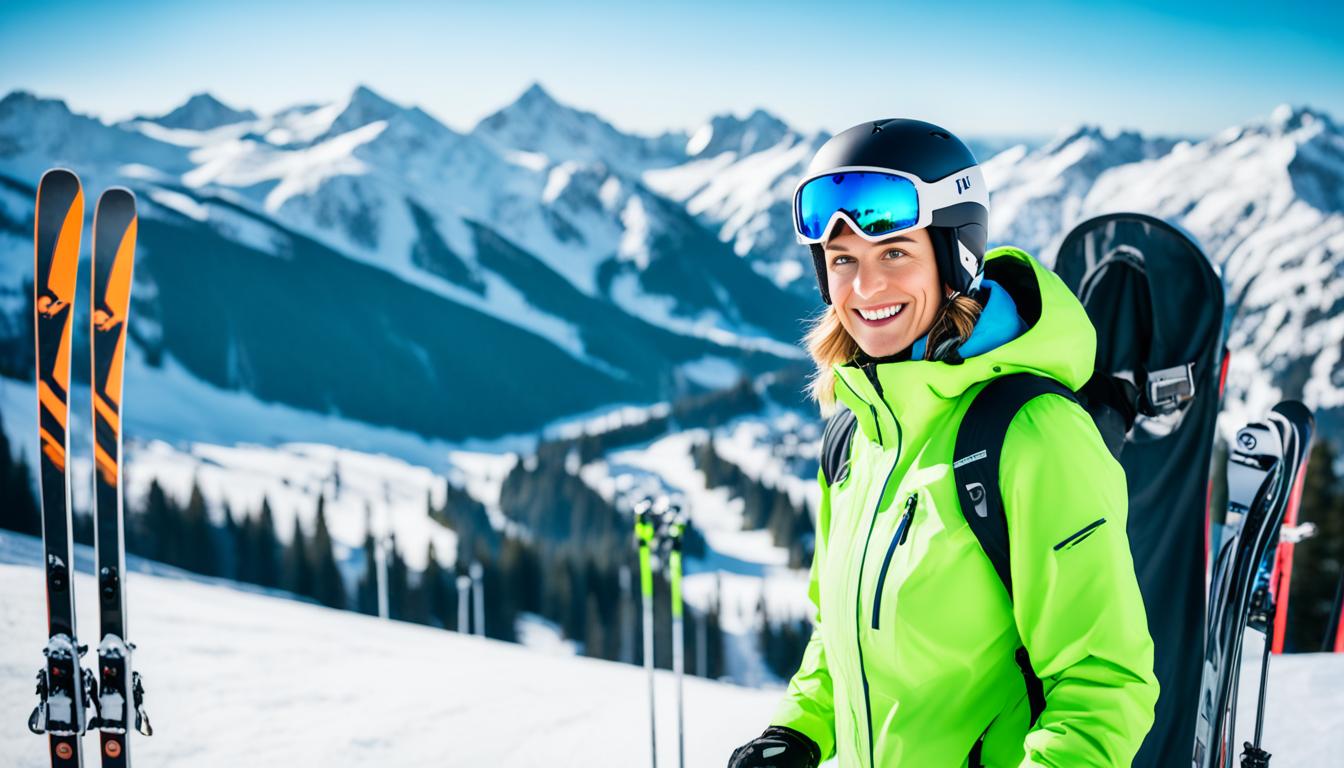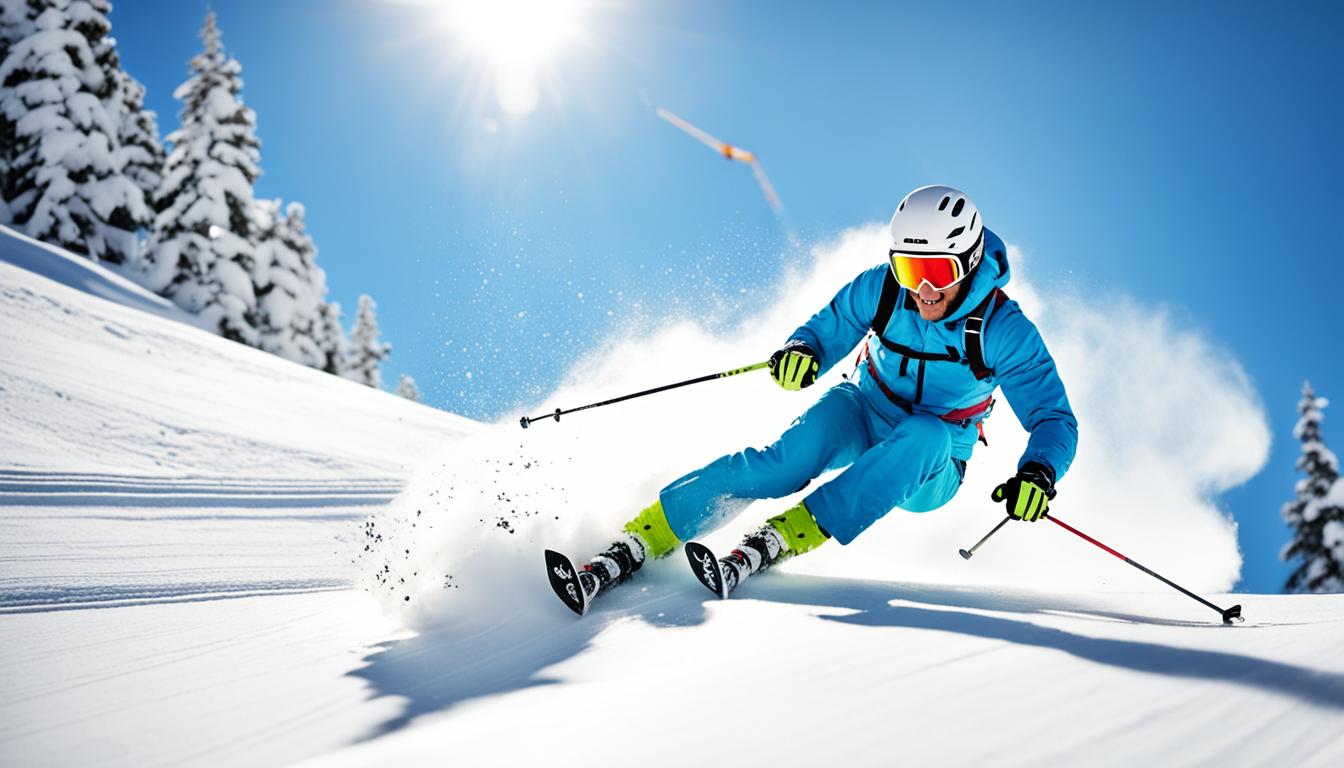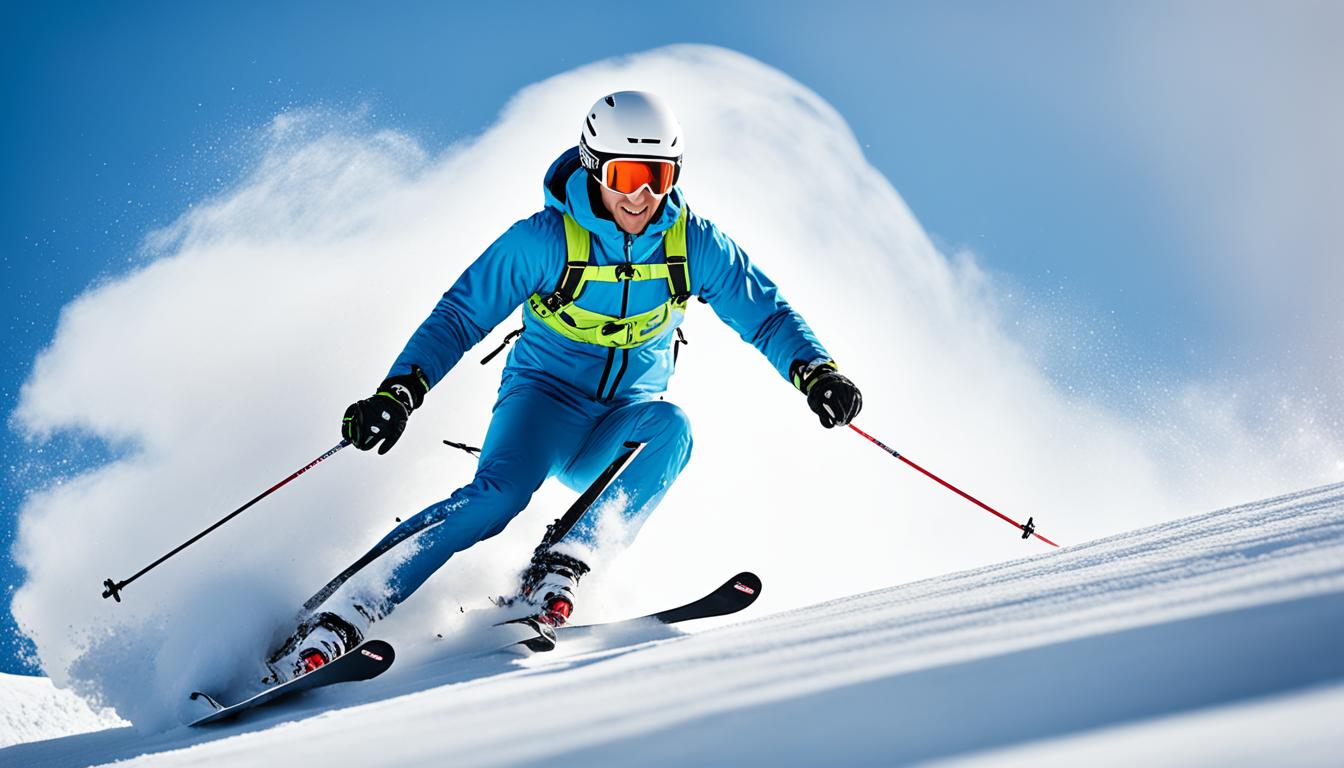Welcome to our beginner ski gear guide, designed to help you make the most of your skiing adventures in Colorado. Whether you’re hitting the slopes for the first time or looking to improve your skills, having the right ski equipment is essential for a safe and enjoyable experience. In this guide, we’ll walk you through the must-have gear for beginners, ensuring that you’re equipped with everything you need to tackle the Colorado slopes with confidence.
Key Takeaways:
- Choosing the right ski equipment is crucial for beginners in Colorado.
- Having the right gear enhances safety and enjoyment on the slopes.
- Invest in essential safety gear such as avalanche beacons, probes, and shovels for backcountry skiing.
- Consider light and smooth skis, versatile bindings, and flexible backcountry ski boots for an optimal backcountry skiing experience.
- Wear proper clothing and accessories, including base layers, outer layers, insulating layers, ski gloves, ski socks, goggles, and a helmet, to stay warm and protected.
Safety Essentials for Backcountry Skiing
When venturing into the backcountry for skiing, safety should be our top priority. To ensure a safe and enjoyable experience, it’s essential to have the right gear. The safety essentials for backcountry skiing include:
- An Avalanche Beacon: This crucial piece of equipment emits and receives signals to locate buried individuals in case of an avalanche. By wearing an avalanche beacon, we increase our chances of being found quickly.
- A Probe: Used to locate the specific area where a person is buried, a probe helps us pinpoint the victim’s location accurately. It is an integral part of the rescue process.
- A Shovel: When an avalanche strikes, time becomes critical. A shovel allows us to quickly and efficiently dig out anyone buried under the snow. It plays a vital role in rescue operations.
These safety essentials are non-negotiable for anyone exploring the backcountry in Colorado. They provide us with the necessary tools to respond effectively in case of an avalanche. By having and knowing how to use these safety essentials, we significantly reduce the risks associated with backcountry skiing. Together, they form the foundation of our safety preparedness.
In the next section, we will explore the specific gear required for backcountry skiing, including skis, bindings, backcountry ski boots, and skins. Let’s make sure we are fully equipped for our backcountry adventure.
Ski Gear for Backcountry Skiing
In addition to the safety essentials mentioned earlier, having the right ski gear is crucial for backcountry skiing in Colorado. Proper equipment will enhance your experience and ensure you have a smooth and enjoyable journey. Let’s take a look at the essential ski gear you’ll need:
Skis
When choosing skis for backcountry skiing, opt for a pair that is lightweight and designed to handle both uphill climbs and powerful downhill descents. Look for skis that provide excellent performance in variable conditions and offer stability and maneuverability.
Bindings
Bindings play a crucial role in backcountry skiing as they need to provide efficient energy transfer during descents and allow for easy mobility on climbs. Look for bindings that have a walk mode for uphill travel and a ski mode for downhill skiing. Adjustable DIN settings are important too, as they allow for customization based on your skill level and personal preference.
Backcountry Ski Boots
Backcountry ski boots are specifically designed to provide the necessary support and flexibility required for both uphill touring and downhill skiing. These boots are lighter than regular alpine boots and usually feature a hike mode and ski mode. The hike mode allows for comfortable and efficient climbing, while the ski mode provides optimal control and performance on descents.
Skins
Skins are an integral part of backcountry skiing gear and are essential for uphill travel. These adhesive strips are attached to the bottom of your skis, allowing you to grip the snow and prevent sliding backward. Ensure you choose skins that are compatible with the length and width of your skis.
| Gear | Description |
|---|---|
| Skis | Lightweight and versatile skis for uphill climbs and downhill descents. |
| Bindings | Bindings with a walk mode for uphill travel and a ski mode for downhill skiing. |
| Backcountry Ski Boots | Lighter and more flexible boots designed for both uphill touring and downhill skiing. |
| Skins | Adhesive strips that provide grip for uphill travel on skis. |
Investing in high-quality ski gear specifically designed for backcountry skiing will ensure you can conquer the mountains with ease and stay safe throughout your adventure.
Having the right ski gear is essential for backcountry skiing. It’s important to choose skis, bindings, boots, and skins that are designed to perform well in various conditions and terrains. This will enhance your overall experience and allow you to make the most of your backcountry adventures.
Clothing and Accessories for Skiing
Proper clothing and accessories are essential for staying warm and comfortable while skiing in Colorado. When hitting the slopes, it’s important to have the right gear to keep you protected from the elements. Let’s explore the essential clothing and accessories for a successful skiing adventure.
Base Layers
Base layers are the foundation of your skiing outfit. These include thermal underwear and ski socks made from wool or synthetic materials. Base layers provide warmth and have moisture-wicking properties, keeping you dry and comfortable throughout your skiing session.
Outer Layers
Outer layers, such as ski jackets and pants, are designed to protect you from snow, wind, and cold temperatures. Look for outer layers with high levels of waterproofing and breathability to ensure you stay dry and comfortable while skiing. These layers are crucial for keeping you warm and protected from the elements.
Insulating Layers
In addition to base and outer layers, insulating layers provide extra warmth in colder climates. Hoodies or sweaters are great options for insulating layers, as they trap heat close to your body and provide an additional layer of protection against the cold.
Ski Gloves
Your hands are exposed to cold temperatures and wind while skiing, making ski gloves an essential accessory. Invest in high-quality ski gloves that offer warmth, flexibility, and waterproofing. Good gloves will keep your hands warm and protected, allowing you to fully enjoy your skiing experience.
Ski Socks
Ski socks are specifically designed to provide comfort, warmth, and moisture-wicking properties. Look for ski socks made from wool or synthetic materials that will keep your feet dry and blister-free throughout your ski day. Properly fitting and cushioned ski socks are crucial for a comfortable and enjoyable skiing experience.
Goggles
Goggles are a must-have accessory when skiing. They protect your eyes from bright sunlight, harsh wind, and flying snow. Choose goggles with UV protection, anti-fog features, and a good fit to ensure clear vision on the slopes. Goggles are essential for both safety and visibility while skiing.
Helmet
Your safety should always be a priority while skiing. Wearing a helmet can greatly reduce the risk of head injuries in case of a fall or collision. Choose a helmet that fits securely and comfortably, providing adequate protection for your head. Always ski with a helmet to ensure a safe skiing experience.
By wearing the right clothing and accessories, you can stay warm, protected, and comfortable while skiing in Colorado. Don’t forget to invest in high-quality gear, as it will enhance your skiing experience and allow you to fully enjoy the mountains.

Gear for Skiing and Snowboarding
When it comes to skiing and snowboarding, having the right gear is crucial. You want to make sure you have everything you need to stay safe and have a great time on the slopes. Here are the essential items you’ll need for both skiing and snowboarding:
Skiing:
- Skis and ski poles: Choose skis that are the right length and style for your skiing ability and preferences. Make sure your ski poles are the correct size as well.
- Ski boots: Invest in a pair of ski boots that fit well and provide the necessary support and comfort for your feet and ankles.
- Helmet: Safety should always be a top priority. Wear a helmet to protect your head from potential injuries on the slopes.
Snowboarding:
- Snowboard and snowboard boots: Choose a snowboard that matches your skill level and riding style. Make sure you have snowboard boots that fit properly and offer the necessary support.
- Helmet: A helmet is just as important for snowboarding as it is for skiing. Protect your head and stay safe while shredding the mountain.
Whether you’re skiing or snowboarding, having the right gear is essential for an enjoyable experience. Make sure to invest in high-quality equipment that suits your needs and fits correctly. If you don’t own your gear, consider renting from a reputable ski shop. They can help you find the right equipment and ensure a proper fit.
Remember, your gear is your best friend on the mountain. Take care of it, maintain it properly, and it will serve you well for many seasons of thrilling skiing and snowboarding adventures.
What to Bring for a Skiing Trip
Aside from the necessary gear, there are a few additional items you should bring on a skiing trip. These essentials will enhance your skiing experience and ensure you’re prepared for any situation.
Goggles
 Goggles are essential for protecting your eyes from the blinding sunlight reflected by the snow. They provide UV protection and shield your eyes from wind, snow, and debris. Choose goggles with anti-fog technology to maintain clear vision throughout your ski adventure.
Goggles are essential for protecting your eyes from the blinding sunlight reflected by the snow. They provide UV protection and shield your eyes from wind, snow, and debris. Choose goggles with anti-fog technology to maintain clear vision throughout your ski adventure.
Hand Warmers
Hand warmers can provide extra warmth and comfort for your hands on particularly cold days. These small packets, when activated, generate heat that lasts for several hours. Slip them into your gloves or pockets to keep your hands cozy and agile on the slopes.
Sunscreen and Lip Balm
Protecting your skin from high-altitude UV rays is crucial while skiing. Apply a broad-spectrum sunscreen with a high SPF to all exposed areas of your skin. Don’t forget to protect your lips with a moisturizing lip balm that contains SPF.
Hydration Pack or Water Bottle
Staying hydrated is essential, even in cold weather. Carry a hydration pack or a water bottle with you on the slopes to ensure you’re replenishing fluids throughout the day. Dehydration can affect your performance and energy levels, so make hydration a priority.
Snacks
Proper nutrition is key to maintaining energy levels while skiing. Pack nutritious and energy-rich snacks such as granola bars, trail mix, fruits, or sandwiches. These portable snacks will keep you fueled throughout the day without weighing you down.
Neck Gaiter
A neck gaiter is a versatile accessory that provides extra warmth and protection against the cold. It can be worn around your neck, pulled up to cover your face, or even used as a headband. Choose one made of moisture-wicking and insulating material to keep you comfortable in various weather conditions.
In Summary
When packing for a skiing trip, be sure to include goggles, hand warmers, sunscreen, lip balm, a hydration pack or water bottle, snacks, and a neck gaiter. These essentials will enhance your comfort, protection, and enjoyment throughout your skiing adventure.
Conclusion
Choosing the right ski equipment is essential for beginners in Colorado to have a safe and enjoyable skiing experience. Each gear piece, from safety essentials to proper clothing and accessories, plays a crucial role in ensuring comfort, protection, and performance on the slopes.
By following this guide and selecting the right gear, beginners can embark on their Colorado skiing adventure with confidence. Prioritizing safety should be the first step, investing in avalanche beacons, probes, and shovels to ensure preparedness for potential emergencies.
Remember to wear appropriate clothing, including base layers, outer layers, and insulating layers to keep warm and dry. Don’t forget to protect your hands, eyes, and head with ski gloves, goggles, and a helmet. Finally, pack essential items like hand warmers, sunscreen, lip balm, and a hydration pack to stay comfortable and hydrated on the slopes.
With the right ski equipment, beginners can embrace the thrill of skiing in Colorado while enjoying the stunning landscapes and powdery snow. So, choose the right gear, stay safe, and make unforgettable memories during your skiing trip in Colorado.
FAQ
What safety essentials do I need for backcountry skiing?
Safety essentials for backcountry skiing include an avalanche beacon, a probe, and a shovel.
What gear do I need for backcountry skiing?
For backcountry skiing, you will need light and smooth skis, bindings that allow for uphill mobility and downhill skiing, and backcountry ski boots with walk and ski modes. You will also need skins that adhere to the bottom of your skis for uphill skiing.
What clothing and accessories do I need for skiing?
To stay warm and comfortable while skiing, you will need base layers like thermal underwear and ski socks, outer layers like waterproof ski jackets and pants, insulating layers like hoodies or sweaters, ski gloves, goggles, and a helmet.
What gear do I need for skiing and snowboarding?
For skiing, you will need skis, ski poles, ski boots, and a helmet. For snowboarding, you will need a snowboard, snowboard boots, and a helmet.
What should I bring for a skiing trip?
You should bring goggles to protect your eyes, hand warmers for extra warmth, sunscreen and lip balm to protect your skin from UV rays, a hydration pack or water bottle to stay hydrated, snacks to maintain energy levels, and a neck gaiter for extra warmth and protection against the cold.




